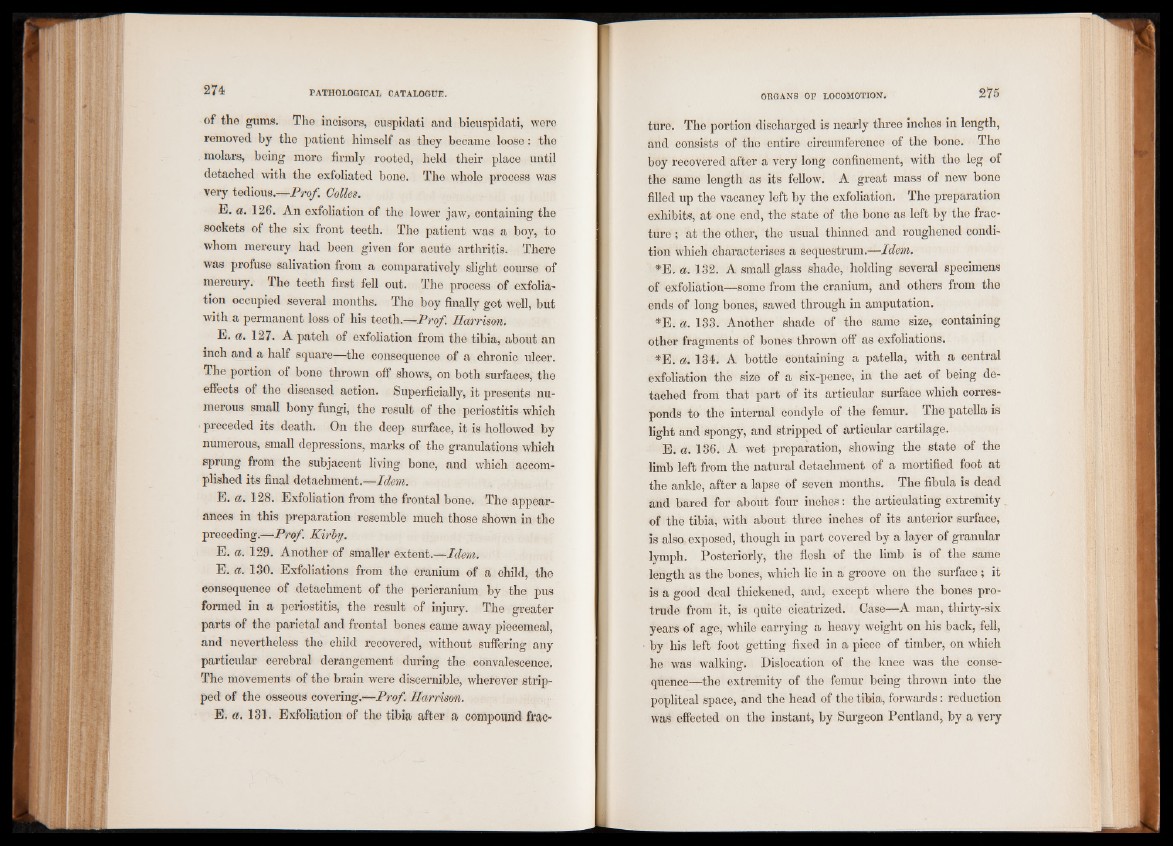
of the gums. The incisors, cuspidati and bicuspidati, were
removed by the patient himself as they became loose: the
molars, being more firmly rooted, held their place until
detached with the exfoliated bone. The whole process was
very tedious.—Prof. Colles.
E. a. 126. An exfoliation of the lower jaw, containing the
sockets of the six front teeth. The patient was a boy, to
whom mercury had been given for acute arthritis. There
was profuse salivation from a comparatively slight course of
mercury. The teeth first fell out. The process of exfoliation
occupied several months. The boy finally got well, but
with a permanent loss of his teeth.—Prof. Harrison.
E. a. 127. A patch of exfoliation from the tibia, about an
inch and a half square—the consequence of a chronic ulcer.
The portion of bone thrown off shows, on both surfaces, the
effects of the diseased action. Superficially, it presents numerous
small bony fungi, the result of the periostitis which
■ preceded its death. On the deep surface, it is hollowed by
numerous, small depressions, marks of the granulations which
sprung from the subjacent living bone, and which accomplished
its final detachment.—Idem.
E. a. 128. Exfoliation from the frontal bone. The appearances
in this preparation resemble much those shown in the
preceding.—Prof. Kirby.
E. a. 129. Another of smaller extent.—Idem.
E. a. 180. Exfoliations from the cranium of a child, the
consequence of detachment of the pericranium by the pus
formed in a periostitis, the result of injury. The greater
parts of the parietal and frontal bones came away piecemeal,
and nevertheless the child recovered, without suffering any
particular cerebral derangement during the convalescence.
The movements of the brain were discernible, wherever stripped
of the osseous covering.—Prof. Harrison.
E. a. 131. Exfoliation of the tibia after a compound fracture.
The portion discharged is nearly three inches in length,
and consists of the entire circumference of the bone. The
boy recovered after a very long confinement, with the leg of
the same length as its fellow. A great mass of new bone
filled up the vacancy left by the exfoliation. The preparation
exhibits, at one end, the state of the bone as left by the fracture
; at the other, the usual thinned and roughened condition
which characterises a sequestrum.—Idem.
*E. a. 132. A small glass shade, holding several specimens
of exfoliation—some from the cranium, and others from the
ends of long bones, sawed through in amputation.
*E. a. 133. Another shade of the same size, containing
other fragments of bones thrown off as exfoliations.
*E. a. 134. A bottle containing a patella, with a central
exfoliation the size of a six-pence, in the act of being detached
from that part of its articular surface which corresponds
to the internal condyle of the femur. The patella is
light and spongy, and stripped of articular cartilage.
E. a. 136. A wet preparation, showing the state of the
limb left from the natural detachment of a mortified foot at
the ankle, after a lapse of seven months. The fibula is dead
and bared for about four inches : the articulating extremity
of the tibia, with about three inches of its anterior surface,
is also exposed, though in part covered by a layer of granular
lymph. Posteriorly, the flesh of the limb is of the same
length as the bones, which lie in a groove on the surface ; it
is a good deal thickened, and, except where the bones protrude
from it, is quite cicatrized. Case—A man, thirty-six
years of age, while carrying a heavy weight on his back, fell,
by his left foot getting fixed in a piece of timber, on which
he was walking. Dislocation of the knee was the consequence—
the extremity of the femur being thrown into the
popliteal space, and the head of the tibia, forwards : reduction
was effected on the instant, by Surgeon Pentland, by a very